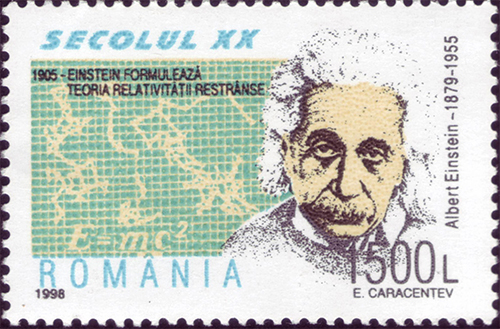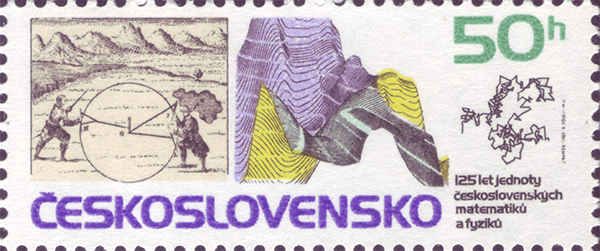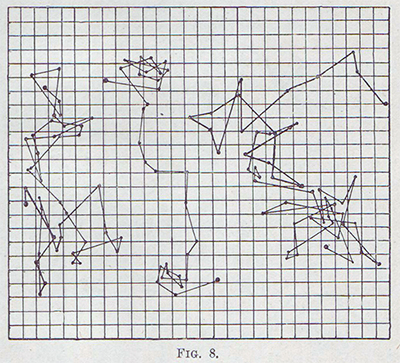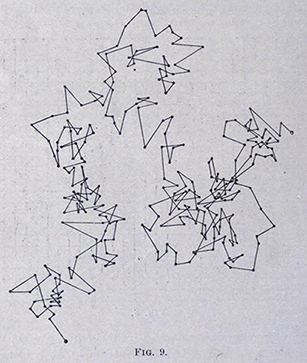

|
Stamps depicting Brownian motion ... or in praise of the often unsung stamp designers. by David Walker, UK |
I am currently rewatching on DVD the splendid ten part series 'Genius' 2017 (National Geographic / Fox21 Television Studios) a drama series recounting the life and work of Albert Einstein. Part three has a section describing the writing of his paper on Brownian motion and included a short clip of his wife Mileva looking down a microscope at Brownian motion in 'pollen particles' (pollen grains are too large to show the motion, it is the released particles from within that show the motion).
Observing Brownian motion is very easy in the liquid phase and a number of articles have been shared on Micscape describing techniques. The fat globules in very dilute milk with slip sealed to avoid convection currents is one of the most accessible. Smoke particles can also be studied and demonstration cells such as the 'Whitley Bay' design for use in schools are available. Although the visible observations are at first perhaps not that striking they are more so because it provided indirect evidence for the existence of atoms and molecules, which was hotly debated at the turn of the 20th century.
I enjoy collecting thematic stamps, particularly on narrow topics related to my interests. Brownian motion is one of my current collecting themes and proving to be a challenging but interesting one because it is such a multifaceted topic; the physical phenomenon and scientists associated with the study, and the mathematicians / physicists who have modelled theoretical aspects including Albert Einstein. The underlying maths (well beyond my understanding!) is also relevant to topics as widely diverging as aspects of finance and molecular machines.
As part of this thematic collection, at least two stamps have been found to date, issued by Romania in 1998 and Czechoslovakia in 1987, that show Brownian motion in the stamp design and are illustrated below.
The respective stamp designers could easily have added a freely drawn design of their own reflecting random particle motion but they did not. Rather both are an accurate transfer of the results of meticulous experimental studies using suspended natural resins (both gamboge and mastic) by Jean Perrin from his book 'Atoms' (English translation by D. Ll. Hammick, 1916, pub. Constable). His work confirmed Einstein's theoretical studies explaining the motion in terms of atoms. Perrin won the Nobel prize for Physics in 1926 "for his work on the discontinuous structure of matter, and especially for his discovery of sedimentation equilibrium".
This example of the attention to detail in stamp design is a tribute to the often unsung stamp designers. They are not often credited on a stamp and is anonymous on the Romanian stamp but is credited on the Czechoslovakian stamp although a hand lens is required to reveal their credits in tiny text. So take a bow 'J. Hamza' who is credited on all three Czech stamps together with three others.


Left.
Romania 1998. 'Secolul XX', one of a set of four showing 20th century achievements. The figure left below is used for this design.
Right.
Czechoslovakia
1987. One of a set of three to celebrate the 125th
anniversary of the Union of Czechoslovak Mathematicians and
Physicists. The design credits are the tiny vertical text on the right.


Left. Figure
8 from Perrin's book 'Atoms'. It shows the plotting of three individual 'mastic' grains 0.53 microns in diameter at 30 second intervals. Perrin notes that sixteen divisions of the grid depict 50 microns.
Right. Figure
9 from Perrin's book 'Atoms', rotated
to the right for the Czechoslovakian stamp design. It records
Perrin's careful plotting of the position of a single microscopic
grain after equal time intervals.
The microscopist familiar with Brownian motion will appreciate the painstaking work that these sort of plots would have required. For Perrin's accurate quantitative studies he describes the time consuming and careful work to produce emulsions with a monodispersed particle size. He remarks:
"In the most careful of my fractionations I treated 1 kilogramme of gamboge and obtained after several months a fraction containing a few decigrammes of grains having diameters approximately equal to the diameter I wished to obtain." 'Atoms' (English translation by D. Ll. Hammick, 1916, pub. Constable)
The author David Walker welcomes any comments.
Published in the August 2020 edition of Micscape.
Please report any Web problems or offer general comments to the Micscape Editor .
Micscape is the on-line monthly magazine of the Microscopy UK web site at Microscopy-UK
© Onview.net
Ltd, Microscopy-UK, and all contributors 1995 onwards. All rights
reserved.
Main site is at www.microscopy-uk.org.uk
with full mirror at
www.microscopy-uk.net
.